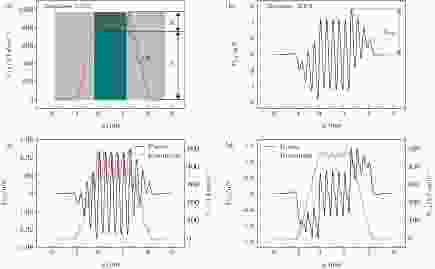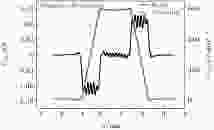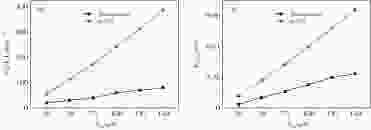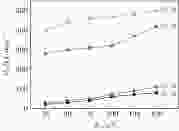全文HTML
--> --> -->石墨烯与其他二维材料之间由于晶格失配, 具有不公度接触构型[16-18], 对减小摩擦具有积极作用, 因此以石墨烯为代表的二维异质结构的摩擦行为也受到了研究者的关注, 如石墨烯与h-BN之间的超低摩擦行为得到了研究者的确认. Leven等[19]研究了方向性、厚度和滑动约束对石墨烯和h-BN之间层间滑动的影响. Wang等[20]研究了氟化石墨烯和MoS2之间的超低摩擦行为. Spear等[21]综述了二维材料应用于控制表面和界面摩擦性能的最新进展.
在目前制备的多种二维材料中, 二维硼烯(Borophene)[22, 23]表现出独特的力学、电学和化学性能[24], 具有良好的应用前景. 程鹏等[25]制备出了单层硼烯, 并指出一些硼烯结构可在大气环境下稳定存在. 但目前对硼烯的摩擦特性以及其与其他二维材料间相互作用的研究较为欠缺. Crisafulli等[26]的研究表明采用解析法研究石墨烯层间滑动的动力学行为具有可行性, 因此本文采用解析法研究了石墨烯和一种稳定的二维平面结构的硼烯之间的层间相互作用, 并与石墨烯和h-BN之间的相互作用相比较, 讨论了硼烯在摩擦学领域应用的可能性.
 图 1 石墨烯在固定基底上滑动的模型 (a) 石墨烯在h-BN上, 模型a; (b) 石墨烯在硼烯上, 模型b
图 1 石墨烯在固定基底上滑动的模型 (a) 石墨烯在h-BN上, 模型a; (b) 石墨烯在硼烯上, 模型bFigure1. Graphene slides on substrates: (a) On h-BN, model a; (b) on borophene, model b.
基于固定基底假设以及石墨烯为刚性的假设, 模型中需要考虑的作用力仅为固定基底和滑动石墨烯之间的范德瓦耳斯力[26-28]. 范德瓦耳斯力采用Lennard-Jones势函数[29]描述:
| 模型 | 原子 | σ/nm | ε/kJ·mol–1 |
| Graphene/h-BN | C—B | 0.343 | 0.329 |
| C—N | 0.338 | 0.407 | |
| Graphene/Borophene | C—B | 0.343 | 0.329 |
表1Lennard-Jones势函数参数表
Table1.Parameters for Lennard-Jones potential.
3.1.石墨烯与h-BN之间的相互作用
由于h-BN在结构上是由B原子和N原子交替连接而成的多个正六边形, 因此分析石墨烯在h-BN上的滑动能够比较由于原子类型的不同而导致的界面间势能起伏的差异. 在h-BN上滑动的石墨烯片由28个原子组成, 其中hx = 2, hy = 3, 在x, y方向上的长度分别为0.57, 0.74 nm. 本文对石墨烯与h-BN之间法向载荷Fz为25, 50, 75, 86, 100, 125和150 nN的情况进行了计算. 由于不同载荷下界面间的作用力和势能曲线具有相似性, 这里选择载荷为86 nN的情况进行讨论.石墨烯中C原子与h-BN中B, N原子间的相互作用以及石墨烯与h-BN间的总作用力和势能如图2所示. 图2(a)显示了滑动过程的三个阶段. 阶段I, 石墨烯从开始进入至刚好完全进入h-BN的过程; 阶段II, 石墨烯在h-BN上滑动的过程; 阶段III 石墨烯从即将开始滑离h-BN至完全滑出h-BN的过程. Ps为阶段I最后时刻所对应的势能数值, Pb为阶段II中势能最大值与最小值的差值, 即界面间势能起伏的幅值. 界面间的最大作用力产生在石墨烯片完全进入h-BN以及石墨烯片即将开始滑离h-BN的时刻, 可将其命为拉出力, 意为滑动片滑离h-BN时需克服的层间作用力, 记作Fexit, 如图2(b)所示.
 图 2 石墨烯与h-BN在相对滑动过程中的层间作用力FLJ与势能VLJ (a) 石墨烯与h-BN之间的势能; (b) 石墨烯与h-BN之间的作用力; (c) 石墨烯中的C与N原子的相互作用; (d) C与B原子的相互作用
图 2 石墨烯与h-BN在相对滑动过程中的层间作用力FLJ与势能VLJ (a) 石墨烯与h-BN之间的势能; (b) 石墨烯与h-BN之间的作用力; (c) 石墨烯中的C与N原子的相互作用; (d) C与B原子的相互作用Figure2. Force and interface potential between graphene and h-BN during the sliding process: (a) The interface potential from phase I to phase III; (b) the force between graphene and h-BN; (c) the interaction between C and N atoms; (d) the interaction between C and B atoms.
图2(c)和图2(d)为石墨烯中的C原子和h-BN中的N, B原子之间的范德瓦耳斯力和势能图. 可知整个滑动过程C, B原子之间的最大层间作用力小于C, N原子之间的作用力. 并且当石墨烯完全在h-BN上滑动时(阶段II), C, B之间的作用力比C, N之间小, C, B之间的Pb值也明显小于C, N之间. 研究者的结果表明[30], 在纳米尺度界面间势能的起伏与摩擦相关. 鉴于此, 石墨烯和硼烯之间的相互作用值得进行探讨.
2
3.2.石墨烯与硼烯之间的相互作用
在石墨烯与硼烯组成的模型中, 基本设定与前一模型类似. 石墨烯依然由28个原子组成, 其中hx = 2, hy = 3, 在x, y方向上的长度分别为0.57, 0.74 nm. 法向载荷Fz也选择25, 50, 75, 86, 100, 125和150 nN进行计算. 图3显示了当界面法向载荷为86 nN时石墨烯与硼烯之间的范德瓦耳斯力和势能图, 曲线形式与石墨烯和h-BN之间的相互作用类似. 图4(a)和图4(b)分别为不同的载荷下, 石墨烯与硼烯和h-BN之间的势能起伏Pb和拉出力Fexit. 可以看出载荷在25—150 nN之间时, 在相同的载荷下, 石墨烯和硼烯之间的势能起伏更小. 由于界面间作用力与势能之间为偏导关系(见(5)式), 势能起伏小意味着界面间相互作用力弱, 摩擦力更小. 此外, 由图4(b)可以看出, 在相同的载荷下石墨烯与硼烯之间的拉出力也更小. 这一结果表明石墨烯与硼烯之间的摩擦可能更小, 并且边界效应更不明显. 图 3 石墨烯与硼烯相对滑动过程中界面间的相互作用力和势能
图 3 石墨烯与硼烯相对滑动过程中界面间的相互作用力和势能Figure3. Force and interface potential between graphene and borophene during the sliding process.
 图 4 不同载荷下石墨烯与h-BN和硼烯之间势能起伏和拉出力 (a) 势能起伏Pb; (b) 拉出力Fexit
图 4 不同载荷下石墨烯与h-BN和硼烯之间势能起伏和拉出力 (a) 势能起伏Pb; (b) 拉出力FexitFigure4. Corrugation and pull out force between graphene and h-BN, borophene under different load: (a) Pb; (b) Fexit.
图5显示了在不同的载荷25, 50, 75, 100, 125和150 nN下, (2, 3), (4, 3), (4, 5)和(6, 5)四种不同尺寸的石墨烯相对硼烯滑动时的Pb值, 其中(2, 3), (4, 3), (4, 5)和(6, 5)尺寸石墨烯的Lx和Ly可以根据(1)和(2)式计算, 其数值分别为0.57, 0.74, 1.42, 0.74 nm和1.42, 1.23, 2.27, 1.23 nm. 可以看出石墨烯片的尺寸与Pb数值的大小为正相关, 原因是原子数的增加增大了界面间的相互作用. 载荷越大Pb的数值越大, 这与文献[26]结果一致.
 图 5 在不同的载荷下, 不同尺寸的石墨烯相对硼烯滑动时界面间的势能起伏
图 5 在不同的载荷下, 不同尺寸的石墨烯相对硼烯滑动时界面间的势能起伏Figure5. Influence of graphene size on Pb under different load
